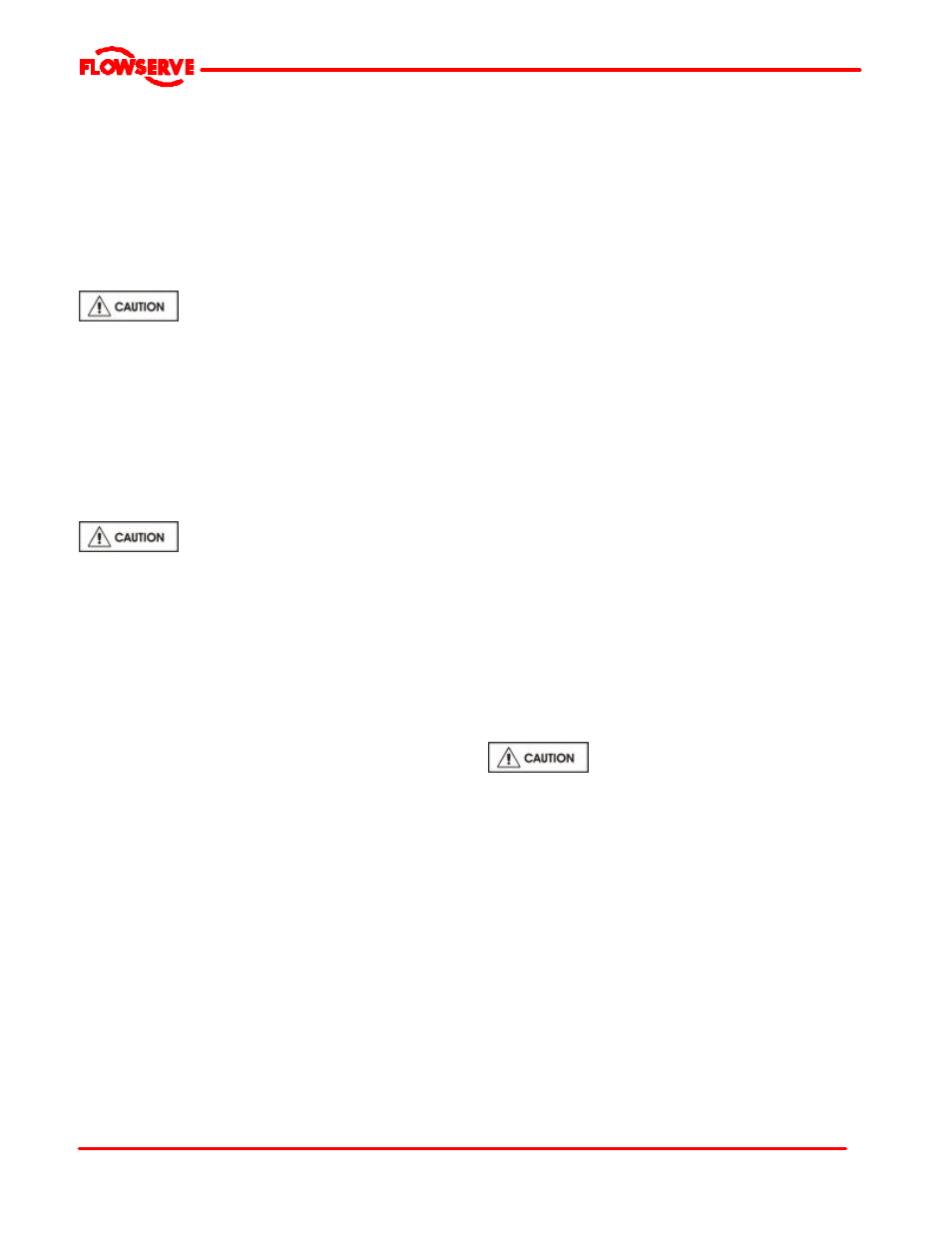Flowserve FRBHJC User Manual
Page 31

FRBHJC USER INSTRUCTIONS ENGLISH 71569179 11-04
Page 31 of 42
®
f) The thrust bearing housing may be removed from
the shaft.
6.8.6 Line Bearing
a) The line bearing is secured in place using a snap
ring as well as an interference fit on the shaft.
Remove the snap ring.
b) The bearing may be removed by using a bearing
puller or can be cut from the shaft using a cutting
torch.
Caution should be used with the cutting torch to
prevent damaging the shaft and sleeve.
6.8.7
a) Remove the shaft sleeve from the shaft. The sleeve
has a locational fit and may be held in place with
an anaerobic sealant.
b) If required, remove bearing frame [19] from the top
plate [23].
6.9 Examination of parts
Used parts must be inspected before
assembly to ensure the pump will subsequently run
properly.
In particular, fault diagnosis is essential to enhance
pump and plant reliability.
6.9.1 Casing, wear plate, stuffing box head and
impeller
a) Inspect for excessive wear, pitting, corrosion,
erosion or damage and any sealing surface
irregularities.
b) Replace as necessary.
6.9.2 Shaft and sleeve
Replace if grooved, pitted or worn.
6.9.3 Gaskets and O-rings
a) After dismantling, discard and replace.
b) Clean and inspect all gasket surfaces.
6.9.4 Bearings and Stuffing Box Bushing
a) It is recommended that bearings are not re-used
after any removal from the shaft.
b) The plain liquid lubricated bearings may be re-used
if both the stuffing box bush and bearing sleeve
show no sign of wear, grooving or corrosion attack.
[It is recommended that both the bush and sleeve
are replaced at the same time.]
6.9.5 Bearing isolators, labyrinths or lip seals
[if fitted]
a) The lubricant, bearings and bearing housing seals
are to be inspected for contamination and damage.
b) If bearing damage is not due to normal wear and
the lubricant contains adverse contaminants, the
cause should be corrected before the pump is
returned to service.
c) Labyrinth seals and bearing isolators should be
inspected for damage but are normally non-
wearing parts and can be re-used.
d) Inspect all bearing lip seals [47 & 49] and replace
move if worn, damaged or in doubt.
6.9.6
Bearing frame and housing
a) Clean and flush bearing housing internal surfaces.
6.10 Assembly
To assemble the pump consult the sectional drawings,
see section 8, Parts list and drawings.
Ensure threads, gasket and O-ring mating faces are
clean. Apply thread sealant to non-face sealing pipe
thread fittings.
The following consumable material are required for
pump assembly.
n high strength thread locking compound equivalent
to Loctite *680 + primer T.
n medium strength thread locking compound
equivalent to Loctite *A.
n anti-seize compound
*Loctite Corporation, Newington, Conn. USA>
Care must be taken during assembly to
avoid contamination of the parts with dirt, or other
foreign matter.
6.10.1 Preparation
a) Inspect all new parts. Remove all nicks, burrs, etc,
that may have been caused by handling.
b) Lubricate internal bores of bearing frame [19] with
same grease used to lubricate bearings.
c) Install the thrust bearing housing [33] into the
applicable bore of the bearing frame [19] to ensure
a good sliding fit, then remove.
d) Clean shaft free of grease at the spacer sleeve [78]
location. Spray the area with Loctite Primer T. The
primer acts as a catalyst to ensure optimum bond
strength and rapid cure of the Loctite compound.
6.10.2 Line Bearings
a) Apply Loctite 680 to the shaft and install the sleeve
[79] at the line bearing against the shaft shoulder.
